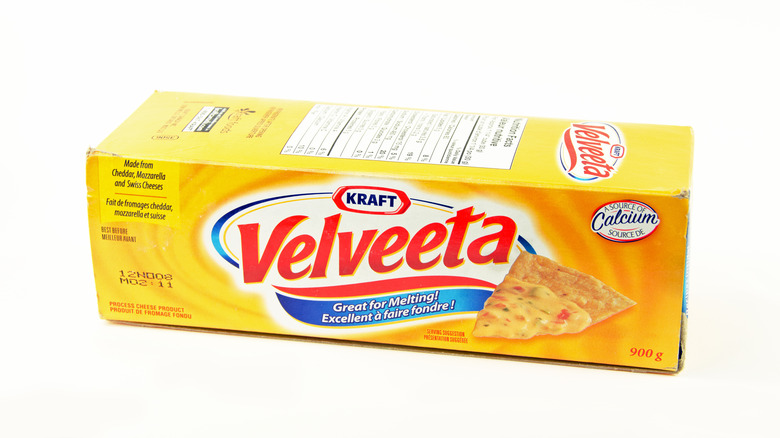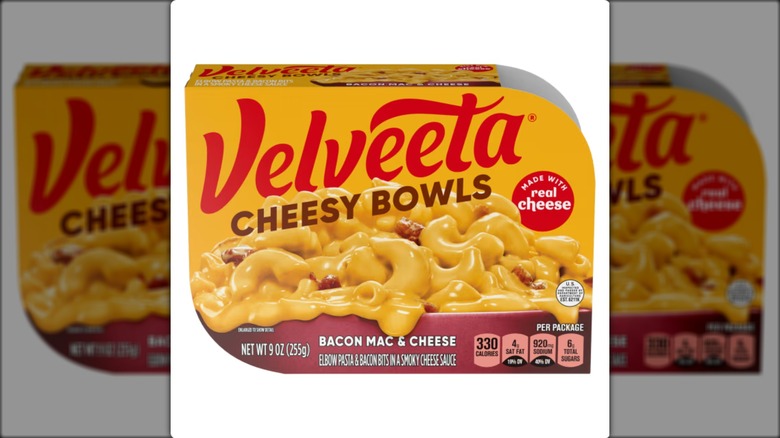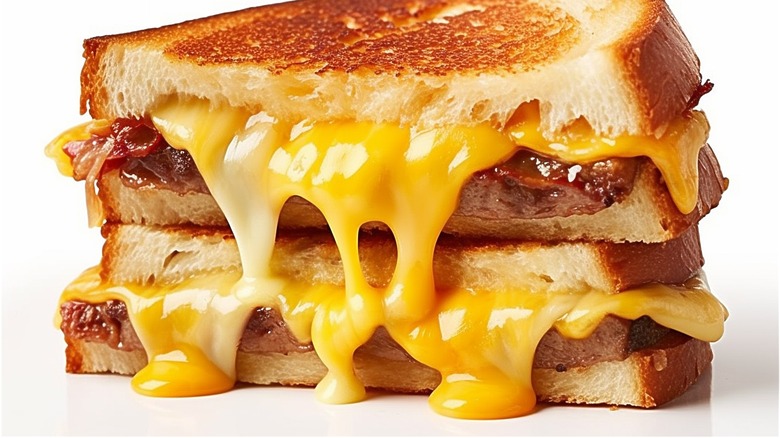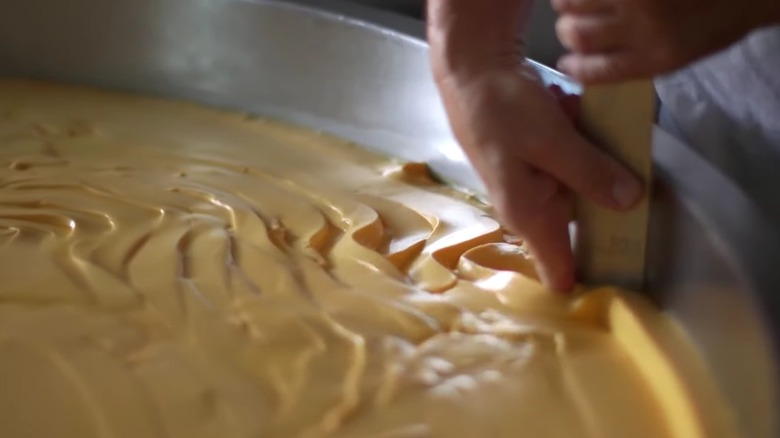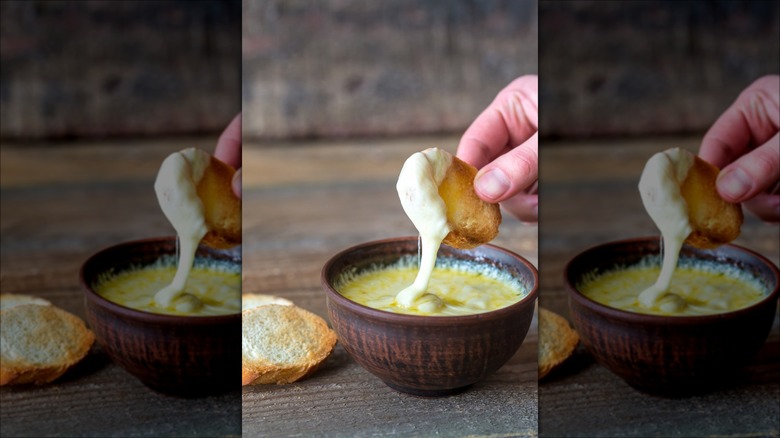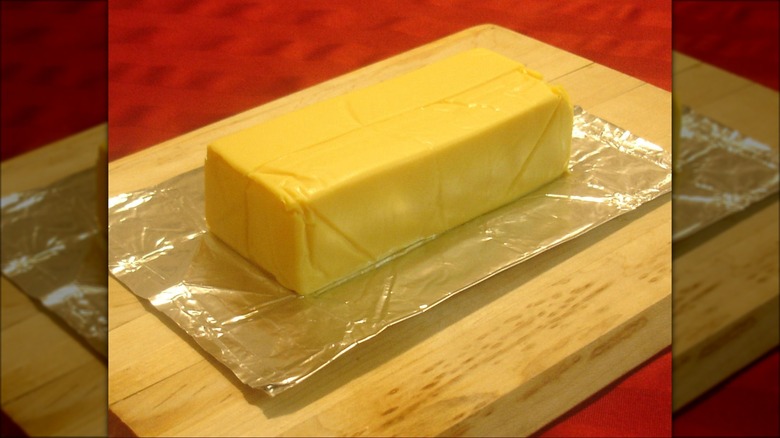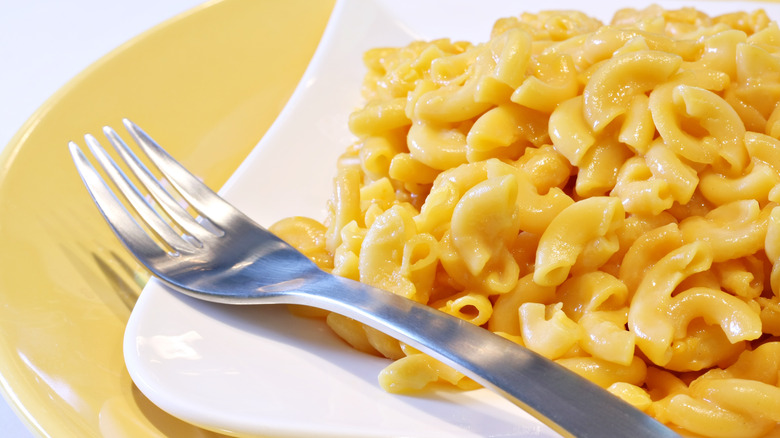How Velveeta Is Really Made
Just about every American has eaten Velveeta at one time or another. In fact, this silky smooth cheese product can be hard to avoid as its used to top many of the country's favorite dishes including hamburgers, and is also used as a delightful, cheesy dip. Thanks to how it is produced, Velveeta is perfectly designed to fulfill these culinary roles, mainly because it retains a smooth homogenous texture when melted. This characteristic puts it at odds with many natural cheeses which leak oil and coagulate when heated.
Due to its ability to melt well, Velveeta is a widely used product in American kitchens. According to cheese historian Laura Werlin, however, the product's popularity is also due to Velveeta's other features as she highlighted to Smithsonian Magazine: "We as a culture have tended to gravitate toward foods that were—and are—predictable, unchanging and relatively bland. Processed cheese fit the bill, and it is also easy to use."
That being said, Velveeta's characteristics including its bright color, and long shelf life have led to many jokes concerning the product's origins. It's often labeled plastic cheese and concerns about its nutritional profile abound. What's more, many Americans are ill-placed to refute these claims, as they are unaware how Velveeta is really made. Thankfully, it's not as an alarming process as some of these jokes would have you believe.
What is Velveeta?
Technically speaking, Velveeta is not cheese, but a pasteurized prepared cheese product. This important distinction was made by the Food and Drug Administration because Velveeta does not employ the ingredients or preparation methods necessary to be legally defined as a cheese. Instead of qualifying as a cheese, the ingredients and manufacturing processes employed to create Velveeta actually result in it being defined as an ultra-processed food.
Despite not being cheese, Velveeta is incredibly popular; a YouGov poll found that 94% of Americans had heard of the brand, while 60% of respondents had a positive opinion of it. Velveeta's popularity is further illustrated through the various forms it is available in. Aside from being sold as a block or in slices, the pasteurized prepared cheese product is used to make a variety of ready meals including so-called cheesy bowls and one-pan dinner kits. Many of these use Velveeta as a sauce that coats other ingredients including meat and pasta.
Velveeta has been produced for over 100 years. Thanks to this long history, the product has become an ingrained part of America's cuisine. This all but ensures its enduring popularity as Laura Werlin explained to Smithsonian Magazine: "For those many, many people who were raised on processed cheese, there is a memory connected with it that can't be discounted in terms of its importance. It's a bite of the past, and that trumps flavor every time."
Velveeta vs American cheese
American cheese is a type of processed cheese, commonplace in the United States. To be categorized as American cheese, the product must be made up of at least 51% cheese. As cheesemaker Brian Civitello explained to Food Network this allows producers to include many different ingredients in the mix when compared to natural cheese: "It allows for a lot more filler and 'approved ingredients' in the mix, which generally results in a lower quality product. I would say it's not technically a natural cheese where milk is coagulated in curds which are then formed into a cheese, but it is composed of natural cheese."
Generally speaking, American cheese has a fat content of around 45% and is loved for its ability to melt into a smooth, gooey mess. The most prominent example of American cheese are Kraft Singles, which are made from cheese and other ingredients such as milk protein concentrate and paprika extract.
While Velveeta melts in a similar fashion to Kraft Singles, it is not technically American cheese. This is because Velveeta does not meet the requisite standards; its not made up of 51% cheese. What's more, Velveeta has a much lower fat content than American cheese, standing around 23%. Despite this, many people still label Velveeta as an 'American cheese.' Thankfully, this confusion isn't too harmful as the two products can be used interchangeably with only minor changes in taste and texture arising as a result.
Velveeta used to be made with spare bits of cheese
Originally, Velveeta was made with the offcuts of various types of cheese, usually a blend of Swiss, cheddar, and Colby. In the early 20th century, these odds and ends were easy to come by as cheese-producing factories invariably created cheese that was not fit for sale. Transforming these scraps into a usable product was a means for these companies to reduce waste and maximize profit. As an added benefit, the processed cheese products that resulted from the process were less likely to become moldy before being sold; a pertinent issue at the time due to the lack of refrigeration.
Unfortunately, producing a homogenous cheese product from different cheese offcuts proved difficult. During the early 20th century, however, people realized that adding an emulsifier called sodium citrate to the cheese offcuts led to the development of a homogenous, processed cheese that did not see its oil separated when heated. Emil Frey, the man who invented Velveeta in 1918, took a different approach by adding whey to achieve the same result. Both techniques yielded an easily manipulated cheese that melted incredibly well. What's more, it was simple to make. All factories had to do after mixing all the ingredients and heating was to mold it into blocks or slices and cool it before packaging the product for the market.
Today, it's made by heating pasteurized milk and emulsifiers
While many processed cheese products including Kraft Singles are still made from melted cheese, Velveeta is not. This is evidenced through Velveeta's ingredient list; cheese is not named as an ingredient, while, for other processed cheese products, such as Kraft Singles, cheese is the first item listed. Instead of cheese, Velveeta is made from pasteurized skim milk that's mixed with emulsifiers such as sodium citrate, whey, and salt while being heated. Other ingredients, including annatto and canola oil, are added for textural and visual purposes.
While cheese is not a named ingredient of Velveeta, sodium citrate is still needed as it breaks down caseins in the mixture and allows the protein molecules to bind to fat molecules during the production process. Essentially, this prevents the fat from separating from the rest of the ingredients when the Velveeta is melted. It is this which gives the product its trademark gooey texture.
This addition of sodium citrate is absolutely to the creation of Velveeta for reasons Lloyd Metzger, a former professor in the department of dairy and food science explained to Inverse: "You change the molecule to interact with fat, so you don't get pools of oil, and then you have it interact with water, and that's how you get that smooth, creamy, runny, appearance without the clumpiness of regular cheese."
How long does Velveeta last?
Aside from helping everything homogenize, heating the mixture during the production process ensures that Velveeta is shelf-stable. In other words, it does not require refrigeration if it remains unopened. Instead, the product should be stored in a cool, dry place. Thanks to its highly processed nature, the product will remain good to consume for months if stored in this manner.
Once it has been opened, Velveeta should be stored in the fridge. For best results place it in an airtight container. In these cold, airtight conditions, an opened packet of Velveeta will last up to eight weeks. As with most other dairy products, mold growth and a bad smell are two signs that Velveeta is past its best and should not be consumed.
Due to its high moisture content, Velveeta does not freeze well; the water crystallizes, ruining its texture and leading the cheese to become grainy. That being said, freezing does extend the product's life by a month or two. However, we'd suggest its compromised characteristics make this practice not worth your while.
Ways to use Velveeta
Velveeta is most often used because of its fantastic melting properties. This is most readily evidenced when the product is used to make fondue. In this instance, the luxurious texture of melted Velveeta coats every piece of dipped bread perfectly. In our recipe, the flavor of the dip is further enhanced through the addition of cream cheese and crab meat, adding an extra dimension to this silky smooth, indulgent meal.
Another way of enjoying Velveeta's wonderful, melted texture is to combine it with other ingredients to make a dip for chips. Chili con queso is a wonderful example of this with pico de gallo, chopped celery, and green peppers lending the melted cheese a much-needed bite.
Finally, Velveeta can be used as an integral ingredient when making rapid mac and cheese. Using Velveeta not only results in a cheese sauce coming together quickly, but also imparts the whole dish with the product's unique flavor, creating a mac and cheese that is both familiar and distinct.
